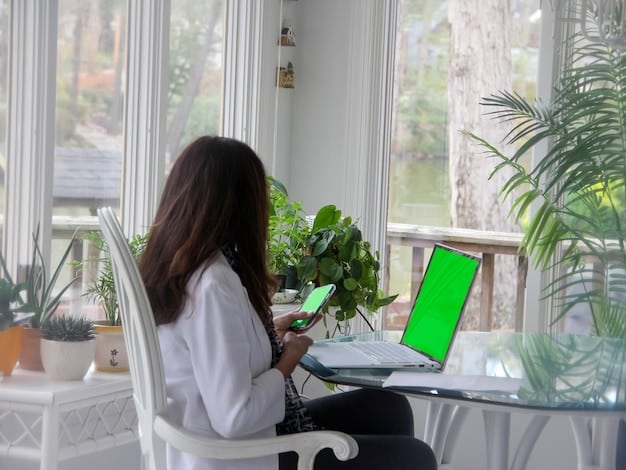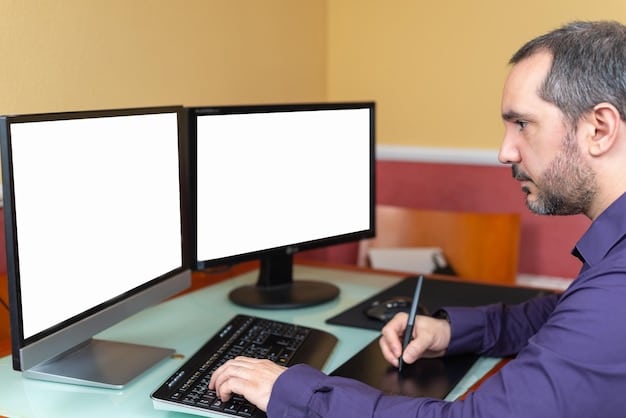Beat Remote Work Burnout: 5 Ways to Regain 15 Hours Weekly

Remote work burnout can significantly impact productivity; however, implementing strategies like time audits, setting boundaries, leveraging automation tools, prioritizing self-care, and optimizing workflows can help reclaim up to 15 hours a week, enhancing overall well-being and output.
Are you feeling overwhelmed and drained by remote work? **Remote work burnout** is a common issue, but it doesn’t have to be your reality. Let’s explore practical strategies to reclaim your time and boost productivity.
Understanding Remote Work Burnout
Remote work offers many benefits, but it also comes with unique challenges that can lead to burnout. Understanding the underlying causes is the first step to addressing the problem effectively. Burnout isn’t just about feeling tired; it’s a state of emotional, physical, and mental exhaustion caused by prolonged or excessive stress.
What Causes Remote Work Burnout?
Several factors contribute to burnout in remote work environments. It’s important to identify these to tailor strategies that address your specific situation.
- Lack of Boundaries: Work easily bleeds into personal life, leading to longer hours and constant availability.
- Isolation: Reduced social interaction can lead to feelings of loneliness and detachment.
- Always-On Culture: The expectation to be constantly connected creates pressure and anxiety.
- Poor Ergonomics: Inadequate workspace setup can cause physical discomfort and strain.
Remote burnout can have huge impacts on anyone who is working from home. It is important to take steps to help resolve the damage, as it can slowly and gradually start to impact work life.
Strategy 1: Conduct a Time Audit
The first step to reclaiming your time is understanding where it’s currently going. A time audit involves tracking your activities throughout the day to identify time-wasting habits and inefficiencies. This data can then be used to make informed decisions about how to better allocate your time.

How to Perform a Time Audit
Performing a time audit might seem daunting, but it can be a straightforward process with significant benefits. Here’s how to do it effectively:
- Track Your Activities: Use a time-tracking app or a simple spreadsheet to log how you spend your time each day for at least one week.
- Categorize Your Tasks: Group similar activities together to identify patterns, such as “Meetings,” “Email,” or “Focused Work.”
- Analyze Your Data: Review the data to identify time sinks and areas where you can improve efficiency.
- Identify Time-Wasting Activities: Pinpoint the activities that consume a significant amount of time without contributing to your goals.
By understanding where your time goes, you can make informed adjustments. This process helps reveal hidden inefficiencies and opportunities to streamline your workflow.
Strategy 2: Set Clear Boundaries
One of the biggest challenges of remote work is the blurring of lines between work and personal life. Setting clear boundaries is crucial for preventing burnout and maintaining a healthy work-life balance. This involves establishing specific work hours, creating a dedicated workspace, and communicating your availability to others.
Tips for Setting Boundaries
Establishing boundaries requires intentional effort and consistent reinforcement. Here are some practical tips to help you set and maintain them:
- Establish Fixed Work Hours: Define specific start and end times for your workday and stick to them as closely as possible. It should feel separate from after work.
- Communicate Your Availability: Let colleagues and family members know when you are available and when you are not.
- Create a Dedicated Workspace: Have a separate area for work. Try not to work in an area that causes stress and anxiety.
- Disconnect Regularly: Take breaks throughout the day, and completely disconnect from work during evenings and weekends.
Boundaries are vital for preventing encroachment of work into personal time, preserving your health, and improving the quality of your relationships. This separation allows for proper refreshment and reduces the chances of burnout.
Strategy 3: Leverage Automation Tools
Automation tools can significantly reduce the time you spend on repetitive tasks, freeing you up to focus on more important and engaging work. From email management to social media scheduling, there are many tools available to streamline your workflow and boost productivity.

Recommended Automation Tools
Investing in the right automation tools can transform your efficiency and reduce the burden of routine tasks. Here are some tools to consider:
- Email Management: Use tools like Boomerang or Mailchimp to schedule emails, automate follow-ups, and manage your inbox more efficiently.
- Project Management: Utilize platforms like Trello or Asana to automate task assignments, track progress, and streamline project workflows.
- Social Media Scheduling: Use tools like Buffer or Hootsuite to schedule posts, analyze engagement, and automate social media management.
By effectively using these and other tools, employees can reclaim valuable hours each week. This time can then be used for focus work, creative ideas, or simply relaxing and rejuvenating.
Strategy 4: Prioritize Self-Care
Taking care of your physical and mental health is essential for preventing burnout and maintaining long-term productivity. Prioritizing self-care involves incorporating activities that help you relax, recharge, and manage stress. This could include exercise, meditation, hobbies, or spending time with loved ones.
Self-Care Practices for Remote Workers
Integrating self-care into your daily routine can make a significant difference in your well-being and productivity. Here are some practices to consider:
- Regular Exercise: Aim for at least 30 minutes of physical activity most days of the week to boost energy and reduce stress.
- Mindfulness and Meditation: Take a few minutes each day to practice mindfulness or meditation to calm your mind and improve focus.
- Hobbies and Interests: Dedicate time to activities you enjoy to relax and recharge.
Self-care is not a luxury; it is a necessity for sustainable productivity. When you prioritize your health, you are better equipped to handle stress and perform at your best.
Strategy 5: Optimize Your Workflow
Optimizing your workflow involves streamlining your processes and eliminating unnecessary steps to improve efficiency. This could include batching similar tasks together, delegating responsibilities, and using productivity techniques like the Pomodoro Technique.
Techniques for Workflow Optimization
Adopting effective workflow techniques can help you accomplish more in less time, reducing the risk of burnout. Here are some methods to try:
- Batching Tasks: Group similar tasks together to minimize context switching and improve focus.
- Delegation: Assign tasks to others when possible to reduce your workload and free up time for more critical responsibilities.
- Pomodoro Technique: Work in focused intervals with short breaks to maintain concentration and prevent mental fatigue.
- Eliminate Distractions: Minimize interruptions by turning off notifications, closing unnecessary tabs, and creating a quiet workspace.
Workflow optimization is about working smarter, not harder. By streamlining your processes, you can reduce stress, increase productivity, and reclaim valuable hours each week.
| Key Point | Brief Description |
|---|---|
| ⏱️ Time Audit | Identify time-wasting activities by tracking how you spend your day. |
| 🚧 Set Boundaries | Establish fixed work hours and a dedicated workspace to avoid work-life overlap. |
| 🤖 Automation Tools | Automate repetitive tasks using tools like email schedulers and project management software. |
| ❤️ Self-Care | Prioritize physical and mental health with exercise, mindfulness, and hobbies. |
Frequently Asked Questions
▼
Signs include constant fatigue, increased irritability, difficulty concentrating, and feeling detached from your work. Recognizing these symptoms early is crucial for taking timely action.
▼
Choose a quiet area, ensure good lighting and ergonomics, and set boundaries to keep work and personal activities separate. A dedicated space helps maintain focus.
▼
Use time-tracking apps, prioritize tasks, and break work into manageable chunks with regular breaks. Techniques like the Pomodoro Technique can enhance efficiency.
▼
Incorporate regular exercise, mindfulness, hobbies, and quality time with loved ones. Taking breaks and disconnecting from work are also essential self-care habits.
▼
Schedule regular virtual meetings, engage in team-building activities, and use communication tools to stay in touch. Maintaining social connections is crucial for combating isolation.
Conclusion
Combating **remote work burnout** requires a proactive and multifaceted approach. By implementing strategies such as time audits, boundary setting, automation tools, self-care practices, and workflow optimization, you can reclaim up to 15 hours a week, boost your productivity, and enhance your overall well-being.





